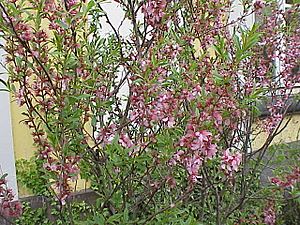Dwarf Russian almond facts for kids
Quick facts for kids Dwarf Russian almond |
|
|---|---|
 |
|
| Conservation status | |
| Scientific classification |
The dwarf Russian almond, also known as Prunus tenella, is a type of deciduous shrub. This means it's a woody plant that loses its leaves every autumn. It naturally grows in the open grasslands, called steppes, of Eastern Europe and Western Siberia. You can also find it in dry, open areas of the Caucasus region, Western Asia, and Central Asia.
This plant produces small, fuzzy fruits that look a bit like tiny almonds and have a special taste. It can grow up to 1.5 meters (about 5 feet) tall. People love to plant it in their gardens, especially in cold places, because it has lots of beautiful flowers in spring and can handle very cold winters. Scientists used to think it was a true almond, but now they know it's actually more closely related to bush cherries, apricots, and plums.
Contents
What is the Dwarf Russian Almond?
The dwarf Russian almond is a small, bushy plant. It's known for its pretty flowers that bloom in spring. These flowers are usually pink or white and appear before the leaves grow. After the flowers, it grows small, fuzzy fruits. Even though they look like almonds, they are not the same kind of almond you might eat as a snack.
Where Does the Dwarf Russian Almond Grow?
This plant is native to a wide area. It likes dry, open places. You can find it growing wild in the vast grasslands of Eastern Europe and Western Siberia. It also grows in dry spots in the Caucasus Mountains and across parts of Western and Central Asia. It's a tough plant that can survive in many different environments.
Why Is It a Popular Plant?
The dwarf Russian almond is a very popular ornamental plant. This means people grow it because it looks good. Gardeners love it for a few reasons:
- Beautiful Flowers: In spring, it's covered in many lovely blossoms.
- Tough in Winter: It's very good at handling cold weather, which is called "winter hardiness." This makes it a great choice for gardens in places with chilly winters.
- Small Size: Its small size makes it fit well in many gardens.
What Does Its Name Mean?
The scientific name for this plant is Prunus tenella. The second part of its name, tenella, comes from Latin. It means "tender" or "delicate." This might seem a bit odd for such a tough plant, but it refers to the plant's delicate appearance when it's covered in blossoms.
Popular Varieties
One well-known type of dwarf Russian almond is called 'Fire Hill'. A cultivar is a specific type of plant that people have grown for certain features. 'Fire Hill' is popular because it has bright red flowers, which stand out beautifully in the spring.


